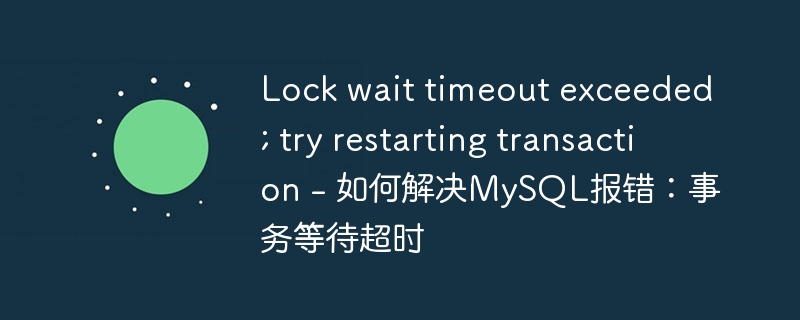

Lock wait timeout exceeded; try restarting transaction - How to solve MySQL error: transaction wait timeout
When using a MySQL database, you may sometimes encounter a common error : Lock wait timeout exceeded; try restarting transaction, this error indicates that the transaction wait timeout has expired. This error usually occurs when accessing the database concurrently, because one transaction locks a resource and other transactions cannot obtain the resource, resulting in a timeout.
So how should we solve this problem? Some common solutions are described next, with specific code examples provided.
BEGIN and ROLLBACK. When we write transaction code, we should pay attention to the following points: START TRANSACTION statement to start a transaction instead of a simple BEGIN statement. COMMIT statement to commit the transaction. SELECT ... FOR UPDATE or SELECT ... LOCK IN SHARE MODE. The following is a sample code that shows how to use appropriate transaction concurrency control:
START TRANSACTION; SELECT * FROM table_name WHERE id = some_id FOR UPDATE; -- 执行一些操作 UPDATE table_name SET column_name = new_value WHERE id = some_id; COMMIT;
SET innodb_lock_wait_timeout = 100;. Note that the timeout is in seconds. The following is a sample code that shows how to adjust the transaction timeout:
SET innodb_lock_wait_timeout = 100;
The following is a sample code that shows how to reduce the size and complexity of transactions:
-- 逐步拆分大事务 START TRANSACTION; -- 第一步操作 COMMIT; START TRANSACTION; -- 第二步操作 COMMIT; -- ... -- 后续操作 COMMIT;
For transaction wait timeout errors, we can use the tools or command lines provided by MySQL to analyze the performance of queries and tables, and make corresponding optimizations.
To sum up, when we encounter the Lock wait timeout exceeded; try restarting transaction error, we should first check the transaction concurrency control, and then adjust the transaction timeout to reduce the size and complexity, and optimize database structures and queries. By applying these solutions properly, we can avoid the occurrence of MySQL transaction wait timeout errors.
I hope the solutions and code examples provided in this article can help you solve the MySQL transaction wait timeout problem.
The above is the detailed content of Lock wait timeout exceeded; try restarting transaction - How to solve MySQL error: transaction wait timeout. For more information, please follow other related articles on the PHP Chinese website!




